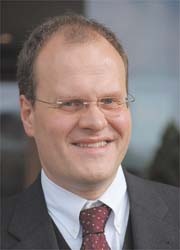Top award for brain-controlled neuroprostheses
We will use the grasping reflex - one of the first reflexes a baby utilises - without thinking for the rest of our lives. However, for those who suffer spinal cord injury of the cervical region, the upper extremities are affected along with the ability to grasp.

Rüdiger Rupp, an engineer at the Orthopaedic University Hospital Heidelberg, has developed a new generation of neuroprostheses, specially for quadriplegic patients. Within a few years, this new device, which is reportedly easy to handle, may be developed to a point where it could fully restore the grasp function. In October, he has been awarded the German Society for Orthopaedics and Orthopaedic Surgery’s Konrad Biesalski Prize for his now internationally acclaimed invention.
Compared to conventional technology, this device, which is implantable or externally used, promises to provide enhanced every-day usability. The first-generation neuroprostheses requires the user to learn complicated auxiliary movements to trigger movement in the prostheses. For example, the right hand is triggered by moving the left shoulder. For his next-generation prostheses Rüdiger Rupp followed a different approach: he used existing, albeit very weak musculature of the right arm to stimulate the right hand. Consequently, the paraplegic can control the grasp movement more easily and does not need a long training phase.
Moreover, the engineer managed to show that a brain that imagines movement triggers changes in electrical activity, which can be used to control movements generated by the neuroprosthesis. To be sure, at this point brain-control still means intensive training, a slow process, but it is the foundation for future progress. ‘Soon,’ he prophesies, ‘brain-control of neuroprostheses will enable patients with injuries of the highest cervical spinal cord and without any residual movement in the arms to operate a complete arm neuroprostheses.’
20.11.2008











